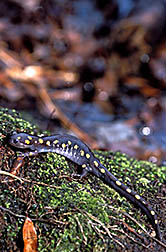This page has been archived and is being provided for reference purposes only. The page is no longer being updated, and therefore, links on the page may be invalid.
USDA Joins Partnership to Protect Rare Forest
By Don ComisJanuary 23, 2006
WASHINGTON, Jan. 23--The Agricultural Research Service (ARS) signed an agreement today with the state of Maryland and other adjacent landowners to protect a 25,660-acre East Coast natural area in the nation's capital region. The signing marks the formation of the Baltimore-Washington Partners for Forest Stewardship to develop a comprehensive Forest Stewardship Plan.
"This natural area with 3,270 acres of forest and 3,230 acres of wetlands is sometimes called the 'green lungs' of the Washington, D.C., metropolitan region, because the trees emit so much oxygen into the atmosphere," said ARS Administrator Edward B. Knipling. "ARS will continue to do its part to exercise good stewardship over this valuable natural resource."
ARS, the U.S. Department of Agriculture's chief in-house scientific research agency, signed the agreement at the Patuxent Research Refuge's National Wildlife Visitor Center in Laurel, Md. Together, the refuge, managed by the U.S. Fish and Wildlife Service, and ARS' adjacent Henry A. Wallace Beltsville (Md.) Agricultural Research Center (BARC) comprise about 20,000 acres of the natural area shared with other government agencies.
ARS and Patuxent joined with the other two major federal land-holding facilities--the U.S. Army's Fort Meade at Laurel and the NASA/Goddard Space Flight Center at Greenbelt--and with the nonprofit Center for Chesapeake Communities to sign a memorandum of understanding with the state of Maryland. The stewardship plan would be designed to be compatible with the mission and ongoing programs of the participating agencies.
USDA has overseen a 13-year sustainable agriculture research program that has reduced pesticide use at BARC by 75 percent and protected the center's streams, one of which supports brown trout that require very clean water.
Also known as the "Green Wedge," the wooded area has long been designated a historic forest research area by the state of Maryland. It has been the site of development of a theory used to determine the amount of forest acreage needed for survival of various bird species. It has also been the site where major national and international bird-counting techniques were developed.
The signing ceremony comes the day after the annual midwinter bird count on the Green Wedge and 22 days after the Audubon Christmas bird count, done mainly by Patuxent and BARC employees.
The Green Wedge is in the watershed of the Chesapeake Bay, so the quality of runoff from this area affects the bay's health.

